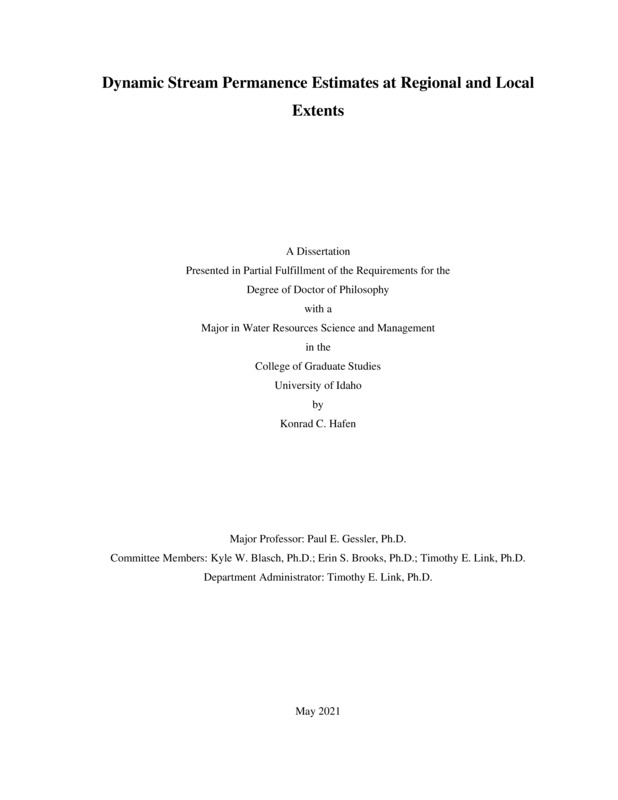Dynamic Stream Permanence Estimates at Regional and Local Extents
Hafen, Konrad. (2021-05). Dynamic Stream Permanence Estimates at Regional and Local Extents. Theses and Dissertations Collection, University of Idaho Library Digital Collections. https://www.lib.uidaho.edu/digital/etd/items/hafen_idaho_0089e_12066.html
- Title:
- Dynamic Stream Permanence Estimates at Regional and Local Extents
- Author:
- Hafen, Konrad
- ORCID:
- 0000-0002-1451-362X
- Date:
- 2021-05
- Keywords:
- Headwater Streams Hydrological Modeling Monthly Water Balance Model National Hydrography Dataset Stream Permanence Watershed Erosion Prediction Project
- Program:
- Water Resources
- Subject Category:
- Hydrologic sciences; Water resources management; Aquatic sciences
- Abstract:
-
In the United States (US), the frequency and duration of surface water in a stream channel (i.e. stream permanence) determines if a stream is subject to regulation under the Clean Water Act. While stream permanence is important for policy implementation, quantifying streamflow and water quantity through observation and modeling has been the primary focus of water resource managers. The most comprehensive dataset of stream permanence classifications for the US is the National Hydrography Dataset (NHD), which gives classifications of perennial, intermittent, or ephemeral for most stream reaches. NHD stream permanence classifications were made during topographic map field surveys that occurred from approximately 1920-2000 and have been shown to exhibit high rates of disagreement with more recent stream permanence observations. Thus, there is currently not an available stream permanence dataset with sufficient accuracy for regulatory determinations. I present three studies to assess the influence of climate in NHD stream permanence disagreements, implement a monthly water balance model (MWBM) to create dynamic stream permanence estimates for headwater streams in the NHD network, and apply the Watershed Erosion Prediction Project (WEPP) hydrologic model to simulate stream permanence in gauged and ungauged watersheds.Analysis of NHD stream permanence disagreements with other stream permanence observations indicates that differences in climate conditions between the years observations were made contributes to the probability of disagreement. This finding supports the need for dynamic simulation of stream permanence based on climate conditions. Dynamic stream permanence estimates for NHD headwater reaches are then calculated using the MWBM, which incorporates climate inputs and hydrological processes to simulate runoff and streamflow permanence. Results from application of the MWBM indicate that more stream permanence data are needed to properly assess process-based models at regional extents. On 40% of headwater streams no MWBM parameter sets were greater than 65% accurate when compared to observations. However, on other headwaters streams MWBM simulations did show some promise for simulating stream permanence. Additional data would encourage and inform further model development. WEPP simulations produced daily stream permanence accuracies up to 93% and annual stream permanence accuracies up to 87% but different parameter sets performed better for daily and annual time steps. These results indicate that, when implemented for stream permanence simulation, assessment of physically-based models should include both daily and annual accuracies. Additionally, future stream permanence data collection methods and methodologies should be strategically planned to capture the spatiotemporal dynamics of stream permanence that are required to effectively develop and evaluate models.
- Description:
- doctoral, Ph.D., Water Resources -- University of Idaho - College of Graduate Studies, 2021-05
- Major Professor:
- Gessler, Paul E
- Committee:
- Brooks, Erin S; Link, Timothy E; Blasch, Kyle W
- Defense Date:
- 2021-05
- Identifier:
- Hafen_idaho_0089E_12066
- Type:
- Text
- Format Original:
- Format:
- application/pdf
- Rights:
- In Copyright - Educational Use Permitted. For more information, please contact University of Idaho Library Special Collections and Archives Department at libspec@uidaho.edu.
- Standardized Rights:
- http://rightsstatements.org/vocab/InC-EDU/1.0/

